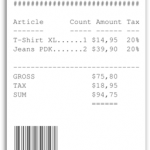The pennant resembles the symmetrical triangle, but it’s characteristics are not the same. The pennants is shaped like a wedge of consolidation. Its normally appears after a sudden upward or downward movement. The life is short according to the time frame used.
The pennant’s pattern is a continuation pattern. The exit side of this pattern depends on the preceded movement. The formation may intervene in a bullish or bearish trend. This break will occur halfway of the movement.
The target calculation is compared to the prior trend. You should calculate the height of the entire movement, up or down before the formation of the pennant and then extend the high on the last low/high point of the pattern.
A graphical representation of a pennant follows:

– In 75% of cases, the exit is made in the side of the previous trend.
– In 90% of cases, this will be a continuation pattern.
– In 55% of cases, the target of the pattern has been reached.
– In 16% of cases, a pullback occurs.
– 84% of cases, a pennant occurs on the lower third annual range when the trend is bearish and the highest third when the trend is bullish.
Pullbacks are harmful for the performance of the pennant pattern.
 Financial Records
Financial Records Whole Foods To Cut 1,500 Jobs!
Whole Foods To Cut 1,500 Jobs! How to Learn More About Investment Advisers
How to Learn More About Investment Advisers